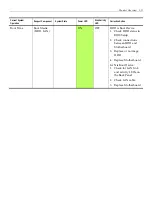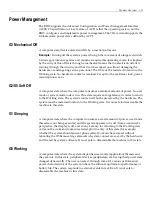
Product Overview 1-13
Power Management
The
BIOS
supports
the
Advanced
Configuration
and
Power
Management
Interface
(ACPI)
2.0
specification.
A
key
feature
of
ACPI
is
that
the
operating
system,
not
the
BIOS,
configures
and
implements
power
management.
The
7611
terminal
supports
the
Global
system
power
states
defined
by
ACPI:
G3 Mechanical Off
A
computer
state
that
is
entered
and
left
by
a
mechanical
means
Example:
Turning
off
the
system
ʹ
s
power
through
the
movement
of
a
large
red
switch.
Various
government
agencies
and
countries
require
this
operating
mode.
It
is
implied
by
the
entry
of
this
off
state
through
a
mechanical
means
that
no
electrical
current
is
running
through
the
circuitry
and
that
it
can
be
worked
on
without
damaging
the
hardware
or
endangering
service
personnel.
The
OS
must
be
restarted
to
return
to
the
Working
state.
No
hardware
context
is
retained.
Except
for
the
real
‐
time
clock,
power
consumption
is
zero.
G2/S5 Soft Off
A
computer
state
where
the
computer
consumes
a
minimal
amount
of
power.
No
user
mode
or
system
mode
code
is
run.
This
state
requires
a
large
latency
in
order
to
return
to
the
Working
state.
The
system
ʹ
s
context
will
not
be
preserved
by
the
hardware.
The
system
must
be
restarted
to
return
to
the
Working
state.
It
is
not
safe
to
disassemble
the
machine
in
this
state.
G1 Sleeping
A
computer
state
where
the
computer
consumes
a
small
amount
of
power,
user
mode
threads
are
not
being
executed,
and
the
system
appears
to
be
off
(from
an
end
user
ʹ
s
perspective,
the
display
is
off,
and
so
on).
Latency
for
returning
to
the
Working
state
varies
on
the
wake
environment
selected
prior
to
entry
of
this
state
(for
example,
whether
the
system
should
answer
phone
calls).
Work
can
be
resumed
without
rebooting
the
OS
because
large
elements
of
system
context
are
saved
by
the
hardware
and
the
rest
by
system
software.
It
is
not
safe
to
disassemble
the
machine
in
this
state.
G0 Working
A
computer
state
where
the
system
dispatches
user
mode
(application)
threads
and
they
execute.
In
this
state,
peripheral
devices
(peripherals)
are
having
their
power
state
changed
dynamically.
The
user
can
select,
through
some
UI,
various
performance/
power
characteristics
of
the
system
to
have
the
software
optimize
for
performance
or
battery
life.
The
system
responds
to
external
events
in
real
time.
It
is
not
safe
to
disassemble
the
machine
in
this
state.
Summary of Contents for RealPOS 50
Page 1: ...NCR RealPOS 50 7611 Release 1 1 User Guide B005 0000 2017 Issue C...
Page 10: ...x...
Page 48: ...1 38 Product Overview...
Page 58: ...2 10 Hardware Installation USB Keyboard w Glide Pad 29246...
Page 88: ...2 40 Hardware Installation...
Page 122: ...6 6 BIOS Updating Procedure...
Page 136: ...7 14 Solid State Drive Optimization...
Page 143: ...2x20 Customer Display Interface 9 5 CP437...
Page 144: ...9 6 2x20 Customer Display Interface CP858...
Page 145: ...2x20 Customer Display Interface 9 7 CP866...
Page 146: ...9 8 2x20 Customer Display Interface CP932...
Page 147: ...2x20 Customer Display Interface 9 9...
Page 148: ...9 10 2x20 Customer Display Interface...
Page 154: ...10 6 Touch Screen Operation...
Page 156: ...A 2 Windows 7...
















































